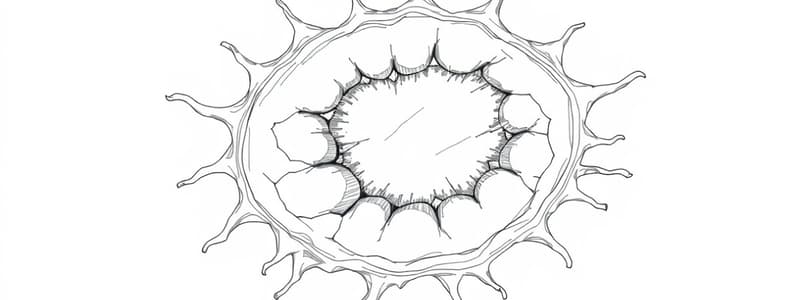Podcast
Questions and Answers
What is the primary characteristic of metaplasia?
What is the primary characteristic of metaplasia?
- Complete degeneration of tissue.
- Permanent transformation of cell types.
- Uncontrolled cell division leading to cancer.
- Reversible transformation of one differentiated cell type to another. (correct)
Which of the following is a type of metaplasia that occurs in response to smoking?
Which of the following is a type of metaplasia that occurs in response to smoking?
- Squamous metaplasia (correct)
- Fibrous metaplasia
- Glandular metaplasia
- Columnar metaplasia
What is one of the primary causes of metaplasia?
What is one of the primary causes of metaplasia?
- Genetic mutations
- Chronic irritation or inflammation (correct)
- Acute infections
- Increased tissue perfusion
Which of the following clinical significances are associated with metaplasia?
Which of the following clinical significances are associated with metaplasia?
How can metaplasia typically be diagnosed?
How can metaplasia typically be diagnosed?
Study Notes
Metaplasia
-
Definition: Metaplasia is the reversible transformation of one differentiated cell type to another differentiated cell type due to chronic irritation or inflammation.
-
Causes:
- Chronic irritation or inflammation (e.g., smoking, gastroesophageal reflux).
- Environmental factors (e.g., toxins, allergens).
- Vitamin deficiencies (e.g., vitamin A deficiency).
-
Types:
- Squamous Metaplasia: Columnar epithelial cells transform into squamous cells (e.g., in the respiratory tract due to smoking).
- Columnar Metaplasia: Squamous epithelial cells transform into columnar cells (e.g., Barrett's esophagus).
-
Mechanism:
- Stem cells in the tissue differentiate into a different cell type.
- Changes in the microenvironment influence gene expression and differentiation processes.
-
Clinical Significance:
- Can be a precursor to dysplasia and cancer (e.g., Barrett's esophagus may lead to esophageal adenocarcinoma).
- May indicate ongoing pathological processes.
-
Reversibility:
- Metaplasia is typically reversible if the underlying cause is removed.
-
Examples:
- Respiratory epithelium in smokers (squamous metaplasia).
- Cervical cells in response to HPV infection (squamous metaplasia).
-
Diagnosis:
- Histological examination through biopsy.
- Imaging studies may reveal changes in tissue architecture.
-
Management:
- Addressing the underlying cause (e.g., cessation of smoking).
- Regular monitoring for potential progression to dysplasia or malignancy.
Definition of Metaplasia
- Reversible transformation of one differentiated cell type into another.
- Triggered by chronic irritation or inflammation.
Causes of Metaplasia
- Chronic sources of irritation, such as smoking and gastroesophageal reflux.
- Environmental toxins and allergens affecting cellular integrity.
- Nutritional deficiencies, notably vitamin A deficiency.
Types of Metaplasia
- Squamous Metaplasia: Conversion of columnar epithelial cells to squamous cells, common in smokers' respiratory tracts.
- Columnar Metaplasia: Transformation of squamous cells into columnar cells, exemplified by Barrett's esophagus.
Mechanism of Metaplasia
- Differentiation of stem cells into alternative cell types based on environmental stimuli.
- Gene expression and cellular differentiation influenced by changes in the tissue microenvironment.
Clinical Significance
- Potential precursor to dysplasia and cancer, with Barrett's esophagus associated with esophageal adenocarcinoma.
- Indicative of ongoing pathological processes and the need for further evaluation.
Reversibility of Metaplasia
- Typically reversible upon removal of the underlying irritant or cause.
Examples of Metaplasia
- Occurrence in respiratory epithelium among smokers (squamous metaplasia).
- Cervical epithelial changes linked to HPV infections (squamous metaplasia).
Diagnosis of Metaplasia
- Histological examination via biopsy to identify cell type changes.
- Imaging studies may show alterations in tissue structure.
Management of Metaplasia
- Focus on eliminating the underlying cause, such as quitting smoking.
- Regular monitoring for progression to dysplasia or malignancy.
Studying That Suits You
Use AI to generate personalized quizzes and flashcards to suit your learning preferences.
Description
This quiz covers the concept of metaplasia, its definition, causes, types, and clinical significance. Explore how chronic irritation or inflammation leads to reversible transformations in differentiated cell types. Test your knowledge on this important topic in pathology.


